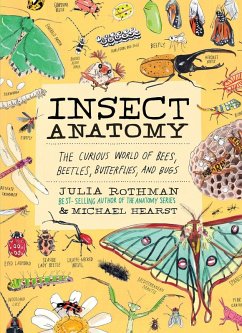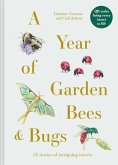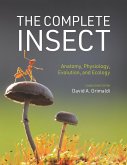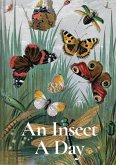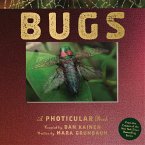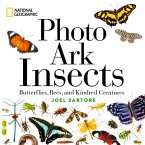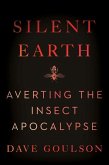Julia Rothman, Michael Hearst
Insect Anatomy
The Curious World of Bees, Beetles, Butterflies, and Bugs
Julia Rothman, Michael Hearst
Insect Anatomy
The Curious World of Bees, Beetles, Butterflies, and Bugs
- Broschiertes Buch
- Merkliste
- Auf die Merkliste
- Bewerten Bewerten
- Teilen
- Produkt teilen
- Produkterinnerung
- Produkterinnerung
Best-selling author/illustrator Julia Rothman expands her popular Anatomy books series with Insect Anatomy, a delightfully illustrated guide to the fascinating insects, bugs, arachnids, and other creatures that populate our planet by the billions.
Andere Kunden interessierten sich auch für
![A Year of Garden Bees and Bugs A Year of Garden Bees and Bugs]() Dominic CouzensA Year of Garden Bees and Bugs16,99 €
Dominic CouzensA Year of Garden Bees and Bugs16,99 €![The Complete Insect The Complete Insect]() The Complete Insect30,99 €
The Complete Insect30,99 €![The Little Book of Spiders The Little Book of Spiders]() Simon Pollard (Adjunct Professor of Science Communication)The Little Book of Spiders14,99 €
Simon Pollard (Adjunct Professor of Science Communication)The Little Book of Spiders14,99 €![An Insect A Day An Insect A Day]() Dominic CouzensAn Insect A Day19,99 €
Dominic CouzensAn Insect A Day19,99 €![Bugs Bugs]() Dan KainenBugs15,99 €
Dan KainenBugs15,99 €![National Geographic Photo Ark Insects National Geographic Photo Ark Insects]() Joel SartoreNational Geographic Photo Ark Insects18,99 €
Joel SartoreNational Geographic Photo Ark Insects18,99 €![Silent Earth Silent Earth]() Dave GoulsonSilent Earth35,99 €
Dave GoulsonSilent Earth35,99 €-
-
-
Best-selling author/illustrator Julia Rothman expands her popular Anatomy books series with Insect Anatomy, a delightfully illustrated guide to the fascinating insects, bugs, arachnids, and other creatures that populate our planet by the billions.
Produktdetails
- Produktdetails
- Verlag: Workman Publishing
- Seitenzahl: 208
- Erscheinungstermin: 2. September 2025
- Englisch
- Abmessung: 228mm x 163mm x 20mm
- Gewicht: 588g
- ISBN-13: 9781635868784
- ISBN-10: 1635868785
- Artikelnr.: 72807903
- Herstellerkennzeichnung
- Libri GmbH
- Europaallee 1
- 36244 Bad Hersfeld
- gpsr@libri.de
- Verlag: Workman Publishing
- Seitenzahl: 208
- Erscheinungstermin: 2. September 2025
- Englisch
- Abmessung: 228mm x 163mm x 20mm
- Gewicht: 588g
- ISBN-13: 9781635868784
- ISBN-10: 1635868785
- Artikelnr.: 72807903
- Herstellerkennzeichnung
- Libri GmbH
- Europaallee 1
- 36244 Bad Hersfeld
- gpsr@libri.de
Julia Rothman is a highly acclaimed contemporary illustrator and author of many best-selling books, including Nature Anatomy, Farm Anatomy, Ocean Anatomy, Food Anatomy, Nature Anatomy Notebook, Wildlife Anatomy, and Insect Anatomy. Her illustrated column, Scratch, ran for five years in the Sunday New York Times. Clients for her illustrations and pattern designs include Target, the Washington Post, MTA Arts & Design, and more. She lives and works in Brooklyn, New York. Michael Hearst is a composer, multi-instrumentalist, and writer, whose projects are characterized by a fascination with extremely specific themes. His most recent project is a four-part book series that includes Unusual Creatures, Extraordinary People, Curious Constructions, and Unconventional Vehicles. Each book includes a companion album, and Unusual Creatures was also made into a PBS Digital series. Hearst is also a founding member of the band One Ring Zero and has performed and given lectures and workshops at universities, museums, and cultural centers around the world. He has toured with The Magnetic Fields, performed with The Kronos Quartet at Carnegie Hall, and appeared on such shows as NPR's Fresh Air, A+E's Breakfast With The Arts, and NBC's The Today Show.
Introduction
Chapter 1: Bugging Out
What Is a Bug?
Insect vs. Spider
Insect Orders
What Is an Arthropod?
The Exoskeleton
These Creatures Are Not Insects
A Timeline of Insects
Anatomy of an Insect
Inside an Insect
Wings and Things
Shapes of Insect Wings
Kinds of Wings
Types of Legs
Insect Eyes
Kinds of Antennae
What Do Insects Eat?
How Insects Eat
Insect Habitats
Beetlemania
Anatomy of a Beetle
Lovely Ladies
Insects Are Important
Climate Change
Chapter 2: Time Flies
Insect Eggs
Insect Growth
Anatomy of a Dragonfly
Life Cycle of a Dragonfly
Aerial Acrobats
Dragonfly vs. Damselfly
Anatomy of a CIcada
The Life Cycle of a Periodical Cicada
The Four Stages of a Moth or Butterfly
Anatomy of a Caterpillar
Is It a Moth or a Butterfly?
Anatomy of a Butterfly
Butterfly Chysalises
This Grows Into That
A Butterfly Showcase
A Moth Showcase
Monarchs' Journey
Mayfly Swarms
Invasion of the Body Snatchers
Chapter 3: Hive Minded
Eusocial
About Ants
Anatomy of an Ant
Ant Antics
Ant Species
Leafcutter Ants
Termites
Anatomy of a Bee
Inside a Bee
Bee Species
Honey Bees vs. Yellow Jackets
And a Hornet?
Wasp Nests
Wasp Species
Chapter 4: Buzzworthy Features
Camouflage and Mimicry
Plants That Mimic Insects
Stick Insects
Bugs with Faces
On the Defensive
The Antlion Death Trap
Stingers
Insect Architects
Big Jumpers
Anatomy of a Grasshopper
Grasshopper Species
Grasshopper vs. Cricket
Crickets as Thermometers
Walking on Water
Diving Deep
Plant + Insect Collaborators
Chapter 5: Bee-yond Words
Waggle Waggle
Strike a Pose
Anatomy of a Mantis
Headshots
Lighting the Sky
Pheromones
Noisy Bugs
Courting and Mating
Lovebugs
Chapter 6: Best in Show
Weirdest
Most Colorful
Best in Black + White
Longest
Fastest
Loudest
Strongest
Biggest
Heaviest
Most Resilient
Cutest
Most Elegant
Brightest
Smallest
Longest-Living
Chapter 7: They Are Among Us
Sleep Tight, Don't Let the Bedbugs Bite
Anatomy of a Mosquito
Good for the Garden
Bad for the Garden
The Elusive Spotted Lanternfly
Chirping in China
Insect Eaters
On the Menu
We Ate Insects!
Everyday Products Made with Insects
Beekeeping
Tiny Flies, Big Discoveries
Flies
Meet Dr. Sunday Ekesi
Insect Fossils
Critically Endangered
Five Things to Help Insects
Go on a Bug Hunt
Build a Bug Hotel
Plant a Butterfly Garden
Recommended Reading & More
Chapter 1: Bugging Out
What Is a Bug?
Insect vs. Spider
Insect Orders
What Is an Arthropod?
The Exoskeleton
These Creatures Are Not Insects
A Timeline of Insects
Anatomy of an Insect
Inside an Insect
Wings and Things
Shapes of Insect Wings
Kinds of Wings
Types of Legs
Insect Eyes
Kinds of Antennae
What Do Insects Eat?
How Insects Eat
Insect Habitats
Beetlemania
Anatomy of a Beetle
Lovely Ladies
Insects Are Important
Climate Change
Chapter 2: Time Flies
Insect Eggs
Insect Growth
Anatomy of a Dragonfly
Life Cycle of a Dragonfly
Aerial Acrobats
Dragonfly vs. Damselfly
Anatomy of a CIcada
The Life Cycle of a Periodical Cicada
The Four Stages of a Moth or Butterfly
Anatomy of a Caterpillar
Is It a Moth or a Butterfly?
Anatomy of a Butterfly
Butterfly Chysalises
This Grows Into That
A Butterfly Showcase
A Moth Showcase
Monarchs' Journey
Mayfly Swarms
Invasion of the Body Snatchers
Chapter 3: Hive Minded
Eusocial
About Ants
Anatomy of an Ant
Ant Antics
Ant Species
Leafcutter Ants
Termites
Anatomy of a Bee
Inside a Bee
Bee Species
Honey Bees vs. Yellow Jackets
And a Hornet?
Wasp Nests
Wasp Species
Chapter 4: Buzzworthy Features
Camouflage and Mimicry
Plants That Mimic Insects
Stick Insects
Bugs with Faces
On the Defensive
The Antlion Death Trap
Stingers
Insect Architects
Big Jumpers
Anatomy of a Grasshopper
Grasshopper Species
Grasshopper vs. Cricket
Crickets as Thermometers
Walking on Water
Diving Deep
Plant + Insect Collaborators
Chapter 5: Bee-yond Words
Waggle Waggle
Strike a Pose
Anatomy of a Mantis
Headshots
Lighting the Sky
Pheromones
Noisy Bugs
Courting and Mating
Lovebugs
Chapter 6: Best in Show
Weirdest
Most Colorful
Best in Black + White
Longest
Fastest
Loudest
Strongest
Biggest
Heaviest
Most Resilient
Cutest
Most Elegant
Brightest
Smallest
Longest-Living
Chapter 7: They Are Among Us
Sleep Tight, Don't Let the Bedbugs Bite
Anatomy of a Mosquito
Good for the Garden
Bad for the Garden
The Elusive Spotted Lanternfly
Chirping in China
Insect Eaters
On the Menu
We Ate Insects!
Everyday Products Made with Insects
Beekeeping
Tiny Flies, Big Discoveries
Flies
Meet Dr. Sunday Ekesi
Insect Fossils
Critically Endangered
Five Things to Help Insects
Go on a Bug Hunt
Build a Bug Hotel
Plant a Butterfly Garden
Recommended Reading & More
Introduction
Chapter 1: Bugging Out
What Is a Bug?
Insect vs. Spider
Insect Orders
What Is an Arthropod?
The Exoskeleton
These Creatures Are Not Insects
A Timeline of Insects
Anatomy of an Insect
Inside an Insect
Wings and Things
Shapes of Insect Wings
Kinds of Wings
Types of Legs
Insect Eyes
Kinds of Antennae
What Do Insects Eat?
How Insects Eat
Insect Habitats
Beetlemania
Anatomy of a Beetle
Lovely Ladies
Insects Are Important
Climate Change
Chapter 2: Time Flies
Insect Eggs
Insect Growth
Anatomy of a Dragonfly
Life Cycle of a Dragonfly
Aerial Acrobats
Dragonfly vs. Damselfly
Anatomy of a CIcada
The Life Cycle of a Periodical Cicada
The Four Stages of a Moth or Butterfly
Anatomy of a Caterpillar
Is It a Moth or a Butterfly?
Anatomy of a Butterfly
Butterfly Chysalises
This Grows Into That
A Butterfly Showcase
A Moth Showcase
Monarchs' Journey
Mayfly Swarms
Invasion of the Body Snatchers
Chapter 3: Hive Minded
Eusocial
About Ants
Anatomy of an Ant
Ant Antics
Ant Species
Leafcutter Ants
Termites
Anatomy of a Bee
Inside a Bee
Bee Species
Honey Bees vs. Yellow Jackets
And a Hornet?
Wasp Nests
Wasp Species
Chapter 4: Buzzworthy Features
Camouflage and Mimicry
Plants That Mimic Insects
Stick Insects
Bugs with Faces
On the Defensive
The Antlion Death Trap
Stingers
Insect Architects
Big Jumpers
Anatomy of a Grasshopper
Grasshopper Species
Grasshopper vs. Cricket
Crickets as Thermometers
Walking on Water
Diving Deep
Plant + Insect Collaborators
Chapter 5: Bee-yond Words
Waggle Waggle
Strike a Pose
Anatomy of a Mantis
Headshots
Lighting the Sky
Pheromones
Noisy Bugs
Courting and Mating
Lovebugs
Chapter 6: Best in Show
Weirdest
Most Colorful
Best in Black + White
Longest
Fastest
Loudest
Strongest
Biggest
Heaviest
Most Resilient
Cutest
Most Elegant
Brightest
Smallest
Longest-Living
Chapter 7: They Are Among Us
Sleep Tight, Don't Let the Bedbugs Bite
Anatomy of a Mosquito
Good for the Garden
Bad for the Garden
The Elusive Spotted Lanternfly
Chirping in China
Insect Eaters
On the Menu
We Ate Insects!
Everyday Products Made with Insects
Beekeeping
Tiny Flies, Big Discoveries
Flies
Meet Dr. Sunday Ekesi
Insect Fossils
Critically Endangered
Five Things to Help Insects
Go on a Bug Hunt
Build a Bug Hotel
Plant a Butterfly Garden
Recommended Reading & More
Chapter 1: Bugging Out
What Is a Bug?
Insect vs. Spider
Insect Orders
What Is an Arthropod?
The Exoskeleton
These Creatures Are Not Insects
A Timeline of Insects
Anatomy of an Insect
Inside an Insect
Wings and Things
Shapes of Insect Wings
Kinds of Wings
Types of Legs
Insect Eyes
Kinds of Antennae
What Do Insects Eat?
How Insects Eat
Insect Habitats
Beetlemania
Anatomy of a Beetle
Lovely Ladies
Insects Are Important
Climate Change
Chapter 2: Time Flies
Insect Eggs
Insect Growth
Anatomy of a Dragonfly
Life Cycle of a Dragonfly
Aerial Acrobats
Dragonfly vs. Damselfly
Anatomy of a CIcada
The Life Cycle of a Periodical Cicada
The Four Stages of a Moth or Butterfly
Anatomy of a Caterpillar
Is It a Moth or a Butterfly?
Anatomy of a Butterfly
Butterfly Chysalises
This Grows Into That
A Butterfly Showcase
A Moth Showcase
Monarchs' Journey
Mayfly Swarms
Invasion of the Body Snatchers
Chapter 3: Hive Minded
Eusocial
About Ants
Anatomy of an Ant
Ant Antics
Ant Species
Leafcutter Ants
Termites
Anatomy of a Bee
Inside a Bee
Bee Species
Honey Bees vs. Yellow Jackets
And a Hornet?
Wasp Nests
Wasp Species
Chapter 4: Buzzworthy Features
Camouflage and Mimicry
Plants That Mimic Insects
Stick Insects
Bugs with Faces
On the Defensive
The Antlion Death Trap
Stingers
Insect Architects
Big Jumpers
Anatomy of a Grasshopper
Grasshopper Species
Grasshopper vs. Cricket
Crickets as Thermometers
Walking on Water
Diving Deep
Plant + Insect Collaborators
Chapter 5: Bee-yond Words
Waggle Waggle
Strike a Pose
Anatomy of a Mantis
Headshots
Lighting the Sky
Pheromones
Noisy Bugs
Courting and Mating
Lovebugs
Chapter 6: Best in Show
Weirdest
Most Colorful
Best in Black + White
Longest
Fastest
Loudest
Strongest
Biggest
Heaviest
Most Resilient
Cutest
Most Elegant
Brightest
Smallest
Longest-Living
Chapter 7: They Are Among Us
Sleep Tight, Don't Let the Bedbugs Bite
Anatomy of a Mosquito
Good for the Garden
Bad for the Garden
The Elusive Spotted Lanternfly
Chirping in China
Insect Eaters
On the Menu
We Ate Insects!
Everyday Products Made with Insects
Beekeeping
Tiny Flies, Big Discoveries
Flies
Meet Dr. Sunday Ekesi
Insect Fossils
Critically Endangered
Five Things to Help Insects
Go on a Bug Hunt
Build a Bug Hotel
Plant a Butterfly Garden
Recommended Reading & More

